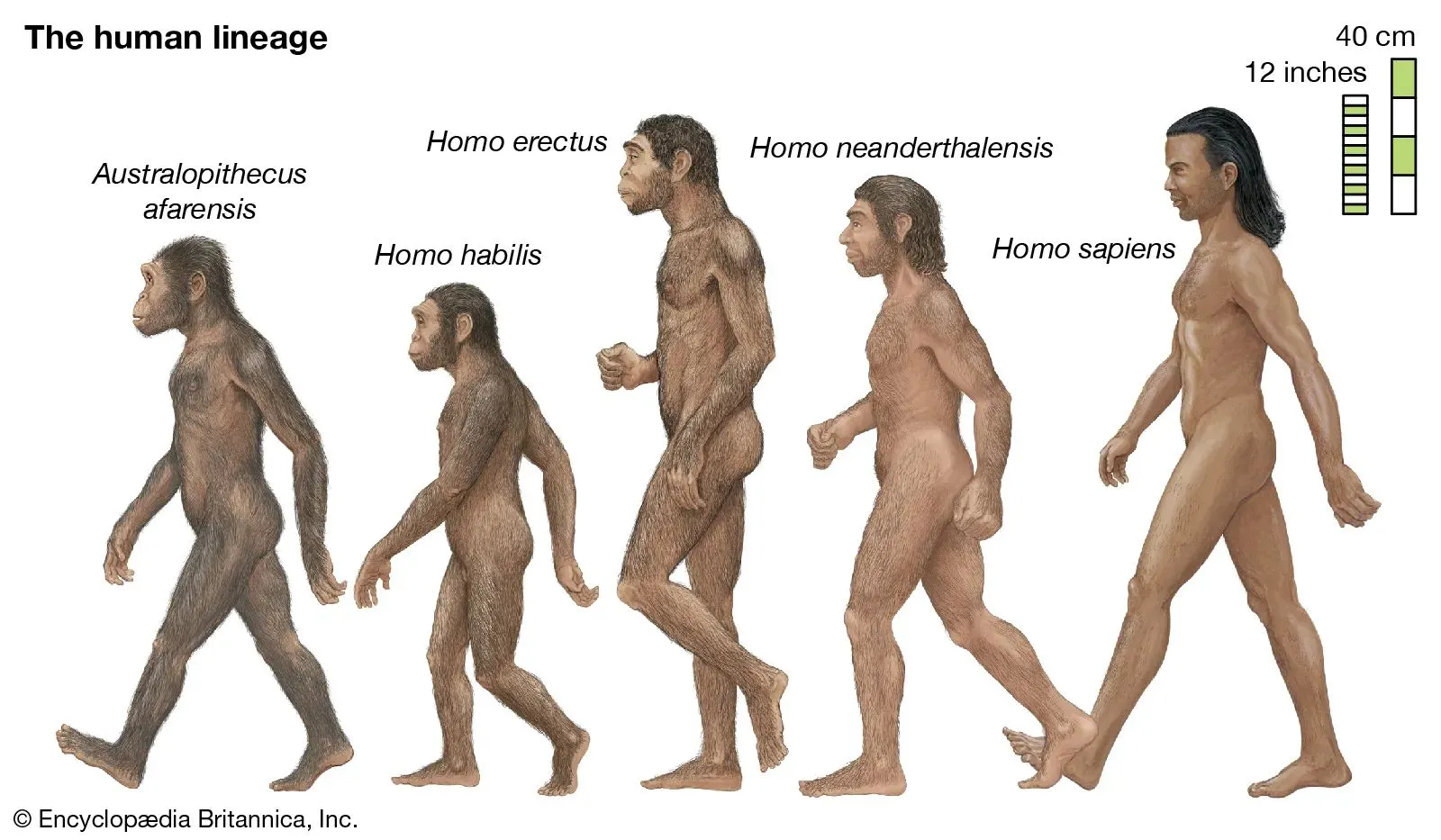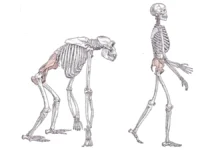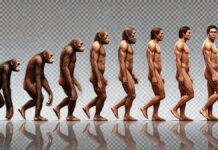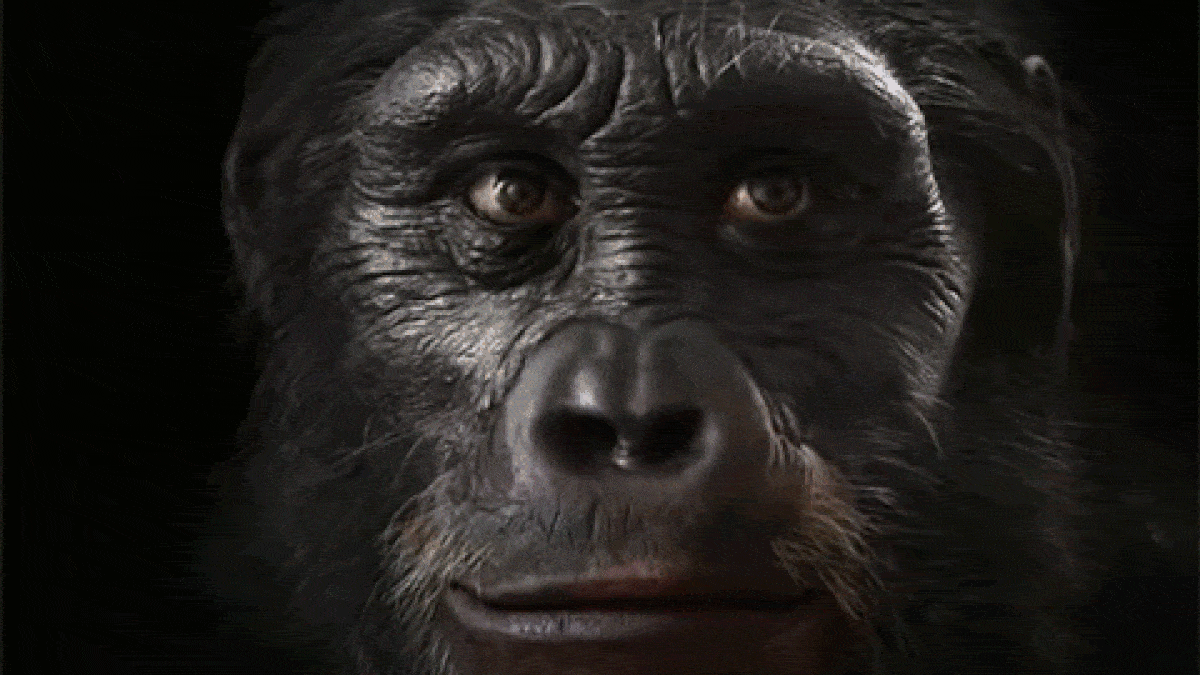Introduction
Intriguing Hypothesis: Could Bipedalism Have Influenced TMJ Dysfunction?
While bipedalism stands as a defining characteristic of human evolution, granting us numerous advantages, a fascinating question arises: could this revolutionary shift in locomotion have come with a hidden cost? This article delves into a captivating hypothesis – that the transition from quadrupedalism to walking upright on two legs might be linked to the increased prevalence of temporomandibular joint (TMJ) dysfunction in modern humans.
Exploring the Potential Connection: A Speculative Journey
It’s important to acknowledge that this is a hypothetical exploration. Currently, there’s no definitive scientific evidence directly connecting bipedalism to TMJ dysfunction in early hominins. However, examining the anatomical changes associated with bipedalism and their potential biomechanical implications on the jaw joint paves the way for a thought-provoking discussion.
This article embarks on a speculative journey, examining the evolutionary adaptations of the jaw and TMJ alongside the emergence of bipedalism. We’ll explore how changes in diet, posture, and craniofacial structure might have influenced TMJ health over time. While this analysis remains open to further scientific exploration, it offers a unique perspective on understanding TMJ dysfunction in the context of human evolution.
By acknowledging the hypothetical nature of the exploration upfront, this text sets the stage for a thought-provoking discussion without misleading readers into believing there’s conclusive scientific evidence. It also sparks curiosity and encourages readers to engage with the ideas presented.
Since its emergence millions of years ago, bipedalism stands as a hallmark of human evolution, fundamentally reshaping our species’ anatomy, behavior, and ecological niche. The transition from quadrupedal ancestors to upright walkers marked a pivotal shift, liberating early hominins’ hands for tool use and facilitating efficient long-distance travel. This adaptation not only influenced our physical form but also laid the foundation for complex social structures and cognitive development.
The evolution of bipedalism profoundly influenced the structure and function of the human jaw and temporomandibular joints. The transition to upright walking precipitated adaptive changes in craniofacial anatomy that optimized locomotor efficiency but also increased the risk of TMJ dysfunction. This evolutionary trade-off underscores the intricate relationship between human locomotion and craniofacial adaptation, highlighting the dual role of bipedalism in shaping both the advantages and challenges of modern human anatomy.
Comparative Anatomy: Jaw and Spinal Adaptations in Bipeds and Quadrupeds
Bipedalism, the defining characteristic of human evolution, introduced profound anatomical changes to various body structures, including the jaw and spine. By comparing these features in bipeds and quadrupeds, we can better understand the evolutionary trade-offs and adaptations required for an upright posture. The jaw, particularly the temporomandibular joint (TMJ), and the spinal column underwent significant modifications to accommodate the mechanical and functional demands of bipedalism.
Jaw and Temporomandibular Joint (TMJ) in Bipeds and Quadrupeds
The jaw and TMJ are central to feeding, communication, and overall craniofacial function. The transition from quadrupedal to bipedal locomotion necessitated adaptations in these structures to maintain balance, optimize functionality, and support the broader changes in posture.
Jaw Morphology
In quadrupeds, the jaw is generally elongated, with a pronounced snout that aids in food acquisition and processing. This structure aligns with their horizontal spinal orientation and contributes to efficient ground-level feeding. The elongated jaw also distributes bite forces evenly, reducing stress on individual components of the jaw and TMJ.
In bipeds, the jaw is more compact and retracted, aligning closer to the vertical axis of the body. This retraction supports speech and facial expressions, essential for complex social interactions. However, the compact structure increases stress on the TMJ, as forces are concentrated in a smaller area during mastication. This concentration of forces is one of the factors contributing to TMJ disorders (TMD) in modern humans.
Temporomandibular Joint Adaptations
The TMJ in quadrupeds is robust, designed to withstand repetitive stress from grinding and chewing fibrous plant materials. The joint operates within a predictable range of motion, reflecting the feeding habits and dietary needs of these species. The forward and backward (protrusion and retraction) movements are particularly well-suited for grinding.
In bipeds, the TMJ accommodates a wider range of motions, including lateral movements critical for varied diets and speech. However, this increased mobility introduces greater vulnerability to misalignment and stress-related disorders. The upright posture of bipeds also shifts the position of the mandible relative to the skull, altering bite mechanics and increasing the likelihood of TMJ strain. The loss of robustness compared to quadrupeds is a trade-off for the versatility needed in human activities.
Spinal Adaptations in Bipeds and Quadrupeds
The spinal column is a structural and functional cornerstone of locomotion and balance. The transition from quadrupedalism to bipedalism required dramatic reconfigurations to the spine to support vertical posture and efficient locomotion.
Quadruped Spine
In quadrupeds, the spine is horizontally oriented, with a relatively uniform curve designed to distribute weight evenly across four limbs. This configuration minimizes strain on individual vertebrae and allows for efficient locomotion on all fours. The horizontal alignment also facilitates head stabilization, critical for maintaining visual focus during movement. The cervical spine (neck) in quadrupeds supports the extended head posture, allowing for ground-level feeding and environmental awareness.
Biped Spine
The bipedal spine exhibits a unique S-shaped curvature, comprising cervical, thoracic, and lumbar curves. This structure is essential for maintaining balance and distributing the body’s weight vertically over the pelvis and lower limbs. The lumbar curvature, or lordosis, is particularly significant in supporting the upper body and compensating for the forward shift of the center of gravity.
However, the bipedal spine is more susceptible to stress and degenerative conditions, such as herniated discs and scoliosis. The vertical orientation places additional load on the lower vertebrae, especially in the lumbar region, leading to frequent back pain in humans. In contrast, quadrupeds rarely experience such issues due to the even weight distribution across all four limbs.
Interaction Between Jaw and Spinal Adaptations
The interdependence of the jaw and spine highlights the complexity of bipedal adaptations. The vertical alignment of the bipedal spine required the repositioning of the head and neck to maintain balance. This repositioning altered the orientation of the jaw and TMJ, increasing reliance on the muscles of mastication and neck stabilization.
Neck and Head Positioning
In quadrupeds, the head’s weight is distributed along the horizontal plane, reducing the strain on neck muscles. The TMJ operates without significant interference from gravitational forces, as the horizontal orientation minimizes stress.
In bipeds, the head’s vertical position shifts the weight balance to the spine’s cervical region, increasing the demand on neck muscles for stabilization. This added strain can influence TMJ function, as the jaw muscles often compensate for neck muscle fatigue or misalignment. Poor posture, a common issue in modern bipeds, exacerbates this strain, creating a feedback loop that heightens the risk of both TMJ disorders and cervical spine issues.
Evolutionary Trade-Offs
The transition to bipedalism brought numerous advantages, such as freeing the hands for tool use and enhancing mobility. However, these benefits came with significant anatomical compromises. The adaptations of the jaw and TMJ, while essential for speech and varied diets, increased susceptibility to disorders due to concentrated forces and greater mobility demands. Similarly, the reconfiguration of the spine allowed for upright posture but introduced vulnerabilities to wear-and-tear conditions.
Implications for Modern Humans
Understanding the evolutionary trade-offs of bipedalism sheds light on the prevalence of TMJ disorders and spinal conditions in modern humans. Sedentary lifestyles and poor posture exacerbate these issues, emphasizing the need for preventive measures and ergonomic awareness. The evolutionary insights into jaw and spinal adaptations can guide therapeutic interventions and inform strategies to mitigate the impact of these conditions.
Evolution and Adaptation of the Temporomandibular Joint (TMJ)
The transition to bipedalism, one of the most significant evolutionary milestones in human history, brought profound changes to the entire musculoskeletal system. Among the less obvious but equally impactful adaptations is the influence of bipedalism on the temporomandibular joint (TMJ). As the sole movable joint in the skull, the TMJ plays a critical role in mastication, speech, and other oral functions. Its evolution reflects the complex interplay between anatomical, biomechanical, and functional changes driven by upright posture and altered dietary demands.
Changes in TMJ Structure Associated with Bipedalism
The TMJ underwent several structural modifications as a result of the shift from quadrupedal to bipedal locomotion. These changes were driven by the repositioning of the head, neck, and jaw to accommodate the vertical alignment of the spine.
Reorientation of the Mandible
In quadrupeds, the mandible is positioned to align with the horizontally oriented spinal column. This alignment allows the jaw to function efficiently under the influence of gravity, with minimal stress on the joint. However, in bipeds, the vertical alignment of the spinal column required the mandible to reposition closer to the cranial base. This reorientation affected the angulation of the TMJ, altering the biomechanics of jaw movement and increasing reliance on surrounding musculature to stabilize the joint.
Restructuring of the Condylar Process
The condylar process of the mandible, which articulates with the temporal bone to form the TMJ, became more compact and rounded in bipeds. This structural adaptation allowed for greater mobility and versatility in jaw movements, including lateral excursions necessary for processing a diverse diet. However, the increased range of motion also introduced greater susceptibility to misalignment and mechanical stress, particularly under repetitive or imbalanced loading conditions.
Cranial Base Modifications
The base of the human skull reflects adaptations to the vertical posture. The anterior displacement of the foramen magnum—the opening through which the spinal cord connects to the brain—brought the head closer to the center of gravity. This change not only improved balance but also affected the spatial relationship between the TMJ, the jaw, and the cervical spine. These shifts had cascading effects on the occlusal plane and the distribution of forces during mastication.
Postural Changes and Their Impact on TMJ Function
The vertical posture associated with bipedalism altered the alignment of the head and neck, directly influencing TMJ function. These postural changes have a profound impact on the interaction between the TMJ, the muscles of mastication, and dental occlusion.
Head and Neck Alignment
In quadrupeds, the horizontal alignment of the spine supports the head with minimal muscular effort. The TMJ operates without significant interference from gravitational forces. In bipeds, however, the head’s vertical orientation introduces additional strain on the cervical spine and associated musculature. This increased load can lead to compensatory changes in TMJ mechanics. For instance, forward head posture, a common modern adaptation exacerbated by sedentary lifestyles, places undue stress on the TMJ by altering the resting position of the jaw.
Dental Occlusion
Bipedalism also influenced the alignment of teeth and the occlusal plane. The retraction of the jaw brought the dental arches into a more compact arrangement, optimizing them for speech and the processing of softer foods introduced during later stages of evolution. However, this compact arrangement also increased the likelihood of malocclusion, where the upper and lower teeth do not align correctly. Malocclusion places uneven forces on the TMJ, contributing to wear-and-tear conditions and dysfunction.
Muscle Dynamics
The muscles of mastication, including the masseter, temporalis, and pterygoid muscles, adapted to support the restructured jaw and TMJ. These muscles became more specialized for precision and controlled movements rather than sheer force, reflecting the dietary shift toward cooked and processed foods. However, these adaptations also rendered the TMJ more vulnerable to dysfunction under conditions of overuse or poor posture. For example, clenching or grinding of teeth (bruxism), often associated with stress or misalignment, can exacerbate strain on the TMJ and surrounding muscles.
Evolutionary Trade-Offs
The adaptations of the TMJ associated with bipedalism reflect a series of evolutionary trade-offs. The enhanced mobility and versatility of the joint allowed for more varied dietary habits and the development of complex speech, both of which were crucial for survival and social interaction. However, these advantages came at the cost of increased susceptibility to mechanical stress and dysfunction.
For instance, the compact nature of the human jaw and the reduced robustness of the TMJ made it more prone to disorders such as temporomandibular joint dysfunction (TMD). Additionally, the vertical alignment of the head and neck created new mechanical challenges, with posture and lifestyle factors further compounding these issues.
Implications for Modern Humans
The evolutionary adaptations of the TMJ provide valuable insights into the prevalence of TMJ disorders in modern populations. Sedentary lifestyles, poor posture, and stress have exacerbated the vulnerabilities introduced by bipedalism. Addressing these issues requires a multidisciplinary approach, incorporating ergonomic awareness, stress management, and therapeutic interventions to restore proper alignment and function.
Understanding Temporomandibular Joint (TMJ) Dysfunction
Temporomandibular joint (TMJ) dysfunction refers to a range of conditions affecting the jaw joint and muscles that control jaw movement. This complex joint connects the mandible (lower jaw) to the temporal bone of the skull in front of each ear. TMJ dysfunction can manifest with various symptoms and is influenced by multiple factors.
Definition and Symptoms of TMJ Dysfunction
TMJ dysfunction encompasses several disorders that affect the jaw joint and surrounding muscles. Common symptoms include pain or tenderness in the jaw joint area, difficulty or discomfort when chewing, clicking or popping sounds in the jaw joint, and locking of the jaw joint, making it difficult to open or close the mouth fully. These symptoms can be intermittent or persistent, impacting daily activities such as eating and speaking.
The exact cause of TMJ dysfunction is often multifactorial and may involve:
Common Causes and Risk Factors
- Jaw Injury or Trauma: Direct impact to the jaw or head, such as from a car accident or sports injury, can damage the TMJ or surrounding muscles, leading to dysfunction.
- Bruxism (Teeth Grinding or Clenching): Habitual teeth grinding or clenching, often due to stress or anxiety, can strain the TMJ and surrounding muscles over time, contributing to dysfunction.
- Arthritis: Various forms of arthritis, including osteoarthritis and rheumatoid arthritis, can affect the TMJ, causing inflammation, pain, and reduced joint mobility.
- Dental Issues: Malocclusion (misalignment of teeth) or missing teeth can alter the bite, placing uneven stress on the TMJ and increasing the risk of dysfunction.
- Muscle Tension: Increased muscle tension in the jaw and neck region, often due to stress, poor posture, or repetitive movements, can strain the TMJ and exacerbate symptoms.
- Genetic Factors: Some individuals may be predisposed to TMJ dysfunction due to genetic factors that affect jaw structure or joint function.
- Gender and Age: TMJ dysfunction is more common in women than men, possibly due to hormonal factors, and tends to peak during childbearing years. Aging can also contribute to changes in joint structure and function.
Evolutionary Background: From Quadrupedalism to Bipedalism
The story of human evolution is marked by significant transitions, none more profound than the shift from quadrupedalism to bipedalism. This transformation not only altered the way early hominin ancestors moved but also reshaped their anatomy and behavior, laying the groundwork for the emergence of modern humans.
Early Hominin Ancestors and Their Movement
Early hominin ancestors, such as Ardipithecus and Australopithecus, were primarily arboreal and adept at moving through forested environments on all fours, similar to modern-day apes. Their skeletal structure, including elongated arms and curved fingers, suited climbing and hanging from branches. This quadrupedal locomotion was efficient for navigating trees but posed challenges for moving on the ground over long distances.
The Anatomical Changes Associated with Bipedalism
Bipedalism, or upright walking on two legs, represented a revolutionary adaptation that set early hominins apart. It freed their hands to manipulate tools and enabled efficient long-distance travel across varied landscapes. This transition involved several key anatomical changes:
- Pelvic Structure: The pelvis of bipedal hominins became broader and more bowl-shaped, providing stability and support for the organs above and accommodating the shift in center of gravity.
- Spinal Curvature: The spine developed distinct curves—cervical, thoracic, lumbar, and sacral—that helped distribute body weight efficiently during upright posture and locomotion.
- Lower Limbs: The legs lengthened relative to the arms, and the feet evolved to form a stable platform with a longitudinal arch for shock absorption and propulsion.
- Foot Anatomy: The foot underwent significant changes, including the development of a robust heel and an arch, which improved balance and energy efficiency during walking and running.
The Role of Diet and Tool Use in Jaw Evolution
Alongside these skeletal adaptations, changes in diet and tool use played crucial roles in shaping early hominins’ jaws and dental structures. As hominins transitioned from primarily herbivorous diets to including more meat and tougher plant materials, their jaws and teeth had to adapt to accommodate these new dietary demands.
- Dental Morphology: Early hominins had larger, more robust jaws with larger teeth suitable for processing tough, fibrous plants. These adaptations enabled efficient chewing and digestion of plant material.
- Introduction of Tools: The ability to use tools for processing food—such as cutting meat and pounding tubers—reduced the need for extensive jaw strength and muscle mass over time. This shift allowed for changes in jaw structure towards a more gracile form, better suited to the new dietary practices.
- Impact on TMJ: The transition to bipedalism and changes in diet likely influenced the temporomandibular joint (TMJ). While specific research linking bipedalism directly to TMJ dysfunction is limited, the evolution of a more upright posture and changes in jaw structure may have altered the biomechanics of the TMJ over time.
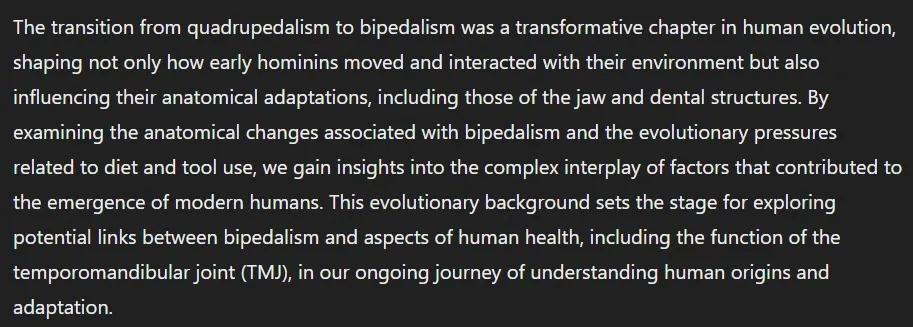
Mandibular Angle and Its Evolution
The mandibular angle, the angle formed between the body of the mandible and the ramus (the vertical portion of the mandible), has evolved significantly throughout human history, reflecting adaptations to changes in locomotion, diet, and craniofacial biomechanics.

The Mandibular Angle in Quadrupedal Ancestors
Early hominin ancestors, primarily quadrupedal like Ardipithecus and Australopithecus, exhibited a mandibular angle that was relatively acute. This feature suited their lifestyle of climbing and foraging in arboreal environments. Their robust jaws and large, powerful teeth were adapted for consuming tough, fibrous plant materials and occasional small prey.
The mandibular angle in these ancestors played a crucial role in the efficient transmission of chewing forces generated during the processing of hard foods. The acute angle helped distribute these forces to the jaw joint and surrounding musculature, supporting their dietary habits and the physical demands of their locomotor behaviors.
Changes in the Mandibular Angle With Bipedalism
The transition from quadrupedalism to bipedalism marked a significant shift in hominin anatomy, including changes in the mandibular angle. As early hominins began to adopt a more upright posture and walk on two legs, their craniofacial structure underwent adaptations to accommodate these new biomechanical demands.
With bipedalism, the mandibular angle became more obtuse. This change was influenced by alterations in overall skull shape, including the positioning of the foramen magnum (the opening through which the spinal cord passes) and adjustments in the placement of facial features relative to the skull base. These adjustments were necessary to maintain balance and alignment of the head on the spine during upright posture.
The increase in the mandibular angle with bipedalism had implications for jaw function and strength. A more obtuse angle meant that the forces generated during chewing were distributed differently across the jaw joint and muscles compared to quadrupedal ancestors. This alteration may have facilitated changes in masticatory mechanics and allowed for greater efficiency in processing foods that required less forceful chewing, such as cooked meats and softer plant materials.
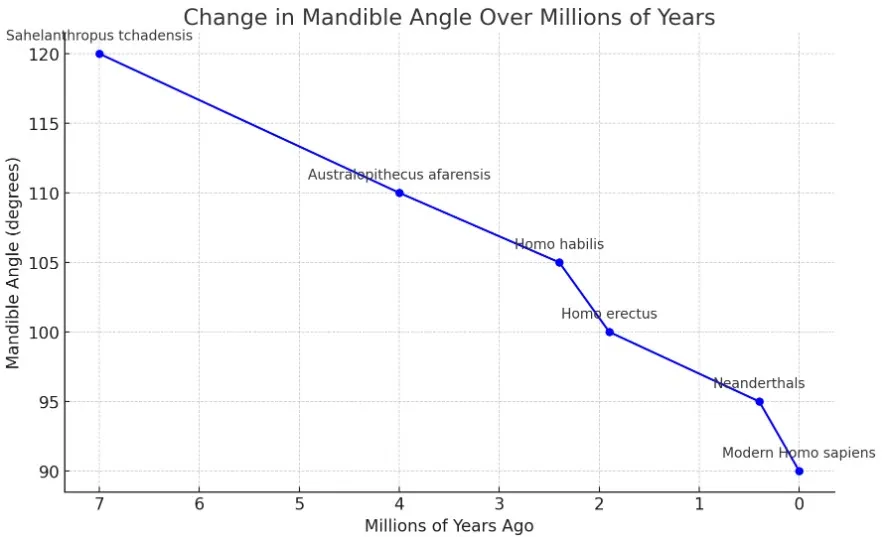
This graph illustrates the change in mandibular angle over millions of years, highlighting significant evolutionary milestones in hominin development:
Sahelanthropus tchadensis (7 million years ago) exhibits a large mandibular angle of approximately 120 degrees, indicative of early hominin jaw structure.
Australopithecus afarensis (4 million years ago) shows a decrease to about 110 degrees, reflecting dietary and anatomical changes.
Homo habilis (2.4 million years ago) continues this trend with an angle of around 105 degrees.
Homo erectus (1.9 million years ago) has a mandibular angle of approximately 100 degrees, further aligning with bipedal adaptations.
Neanderthals (0.4 million years ago) exhibit a reduced angle of 95 degrees.
Modern Homo sapiens present the smallest angle at 90 degrees, showcasing the culmination of these evolutionary changes.
Implications for Jaw Strength and Function
The evolution of a more obtuse mandibular angle in bipedal hominins likely corresponded with changes in jaw strength and function. While the robust jaws and large teeth of quadrupedal ancestors were well-suited for processing tough, fibrous foods, the more gracile jaws of bipedal hominins reflected adaptations to a diet that increasingly included softer, processed foods.
These adaptations had implications for overall craniofacial biomechanics, including the function of the temporomandibular joint (TMJ). Changes in the mandibular angle and associated craniofacial adaptations influenced how forces were transmitted during chewing and speaking, potentially impacting TMJ health and function over evolutionary time.

Bipedalism and Its Impact on the Jaw and TMJ
How Bipedalism Influenced Craniofacial Anatomy
The evolution of bipedalism marked a pivotal shift in human anatomy, particularly affecting the craniofacial region. As early hominins adapted to walking upright approximately 4 to 6 million years ago, significant changes occurred in the structure and function of their jaws and temporomandibular joints (TMJ). Bipedalism necessitated alterations in posture, balance, and locomotion, which in turn exerted selective pressures on craniofacial features.
One prominent adaptation linked to bipedalism is the reshaping of the skull and mandible. The foramen magnum, originally positioned towards the rear in quadrupeds, shifted centrally beneath the skull in bipeds to align with the spinal column’s vertical orientation. This adjustment facilitated a more efficient balance and distribution of body weight over the legs during upright walking. Concurrently, the mandible underwent changes to accommodate the new demands of chewing and speaking in an upright posture. These adaptations reflect a complex interplay between form and function in response to bipedal locomotion.
The Relationship Between Jaw Structure and TMJ Dysfunction
The transition to bipedalism brought about alterations in jaw structure that have implications for temporomandibular joint dysfunction (TMJD). The human jaw evolved from a robust, prognathic form in earlier hominins to a more gracile structure in modern humans. This shift involved changes in dental arcade shape, tooth size, and mandibular symphysis configuration to support the increased demands of mastication and phonation in an upright stance.
TMJ dysfunction arises when the complex system of muscles, ligaments, and the joint itself that controls jaw movement becomes impaired. Factors contributing to TMJD include mechanical stress from chewing, abnormal bite alignment, and genetic predispositions exacerbated by the biomechanical adjustments associated with bipedalism. The transition to upright posture altered the distribution of forces on the mandible and surrounding structures, potentially leading to increased susceptibility to joint disorders over evolutionary time.
Hypothesizing the Trade-off: Increased TMJ Issues as a Cost of Bipedalism
A compelling hypothesis posits that the advantages of bipedalism, such as enhanced mobility and energy efficiency, came at the cost of increased TMJ dysfunction. The biomechanical stress imposed by upright walking necessitated adjustments in craniofacial anatomy that inadvertently heightened vulnerability to joint-related ailments. As humans adapted to bipedal locomotion, evolutionary pressures favored changes in jaw morphology that optimized chewing efficiency but also introduced biomechanical compromises predisposing individuals to TMJD.
Furthermore, the evolutionary trajectory of human craniofacial anatomy suggests a trade-off between adaptability to bipedalism and susceptibility to TMJ issues. While bipedalism conferred numerous advantages for survival and reproduction, including enhanced visual surveillance and freed hands for tool use, it simultaneously reshaped the craniofacial complex in ways that potentially compromised joint function over evolutionary time.

Modern Human Jaw and TMJ: A Comparative Perspective
Understanding the evolution and current state of the human jaw and temporomandibular joint (TMJ) involves examining both historical adaptations and contemporary influences. This comparative perspective sheds light on how changes in diet, lifestyle, and anatomy have shaped the function and health of the TMJ in modern humans.
Differences in Jaw Anatomy Between Early Hominins and Modern Humans
Early hominins, such as Ardipithecus and Australopithecus, possessed robust jaws with large teeth suited for chewing tough, fibrous vegetation and occasional meat. Their dental arches were broad and their mandibles robust, reflecting adaptations for a primarily herbivorous diet and the mechanical demands of processing coarse foods.
In contrast, modern humans exhibit a more gracile jaw structure and reduced dental robusticity. This evolution is attributed to dietary shifts from hunting and gathering to agriculture and, more recently, to processed foods. The reduction in jaw size and tooth size corresponds with changes in dietary habits, including the consumption of softer, cooked foods that require less mechanical processing.
Modern Diets and Lifestyle Factors Affecting the TMJ
The transition to modern diets rich in processed sugars, soft foods, and mechanically altered textures has impacted TMJ health. Soft diets reduce the need for vigorous chewing, potentially affecting the development and strength of the jaw muscles and the alignment of the TMJ. Additionally, excessive consumption of processed foods and sugars has been associated with inflammatory responses that may affect TMJ function and contribute to disorders such as arthritis.
Lifestyle factors also play a significant role. Habits like teeth grinding (bruxism), often linked to stress and anxiety, can place undue stress on the TMJ and surrounding muscles. Poor posture, exacerbated by prolonged use of digital devices, can lead to neck and jaw strain, altering TMJ alignment and function over time.
The Prevalence of TMJ Dysfunction Today
TMJ disorders are increasingly prevalent in modern society, affecting individuals of all ages and demographics. Common symptoms include jaw pain, clicking or popping noises when chewing, difficulty opening or closing the mouth, and headaches. These symptoms can significantly impact daily life and may worsen without proper treatment.
Contributing factors to TMJ dysfunction include biomechanical stressors from poor posture and repetitive jaw movements, as well as genetic predispositions and hormonal influences. Women are disproportionately affected, possibly due to hormonal fluctuations and differences in jaw anatomy.
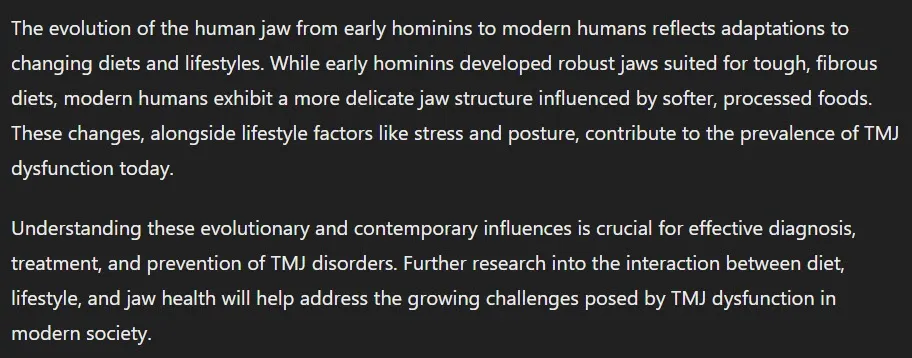
Current Research and Future Directions
Exploring the evolutionary roots and modern implications of temporomandibular joint (TMJ) dysfunction requires bridging gaps in research and expanding interdisciplinary approaches. This overview examines the current state of knowledge, identifies research deficits, and suggests future directions for investigating the intersection of bipedalism and TMJ health.
The Lack of Direct Research on TMJ Dysfunction in Early Hominins
Research on TMJ dysfunction primarily focuses on modern humans, with limited direct evidence from early hominins. Early hominins, such as Ardipithecus and Australopithecus, lacked detailed skeletal remains necessary for comprehensive TMJ analysis. This gap in direct evidence hinders understanding of TMJ health in ancestral species and the evolutionary pathways leading to modern TMJ dysfunction.
The Need for Interdisciplinary Studies Combining Paleontology, Anatomy, and Clinical Research
To address these gaps, future research should integrate paleontological findings, anatomical studies, and clinical research methodologies. Paleontological discoveries offer insights into early hominin diets, behaviors, and craniofacial adaptations. Comparative anatomical studies across primate species provide context for understanding evolutionary changes in jaw morphology and TMJ function. Clinical research contributes diagnostic tools and treatment strategies for modern TMJ disorders, informing hypotheses on ancestral TMJ health.
Potential Avenues for Future Research on Bipedalism and TMJ Dysfunction
Future research directions include:
- Paleoanthropological Investigations: Enhanced fossil discoveries and advanced imaging techniques can provide new insights into early hominin craniofacial morphology and TMJ adaptations. Comparative analyses with modern primates and diverse human populations offer evolutionary perspectives on TMJ health.
- Biomechanical Modeling: Computational simulations and biomechanical models can assess the functional implications of bipedalism on TMJ loading and stress distribution. These models integrate fossil data with modern biomechanical principles to reconstruct TMJ function in early hominins.
- Clinical Studies: Longitudinal studies on modern populations can explore correlations between skeletal morphology, dental occlusion, and TMJ dysfunction. These studies inform hypotheses on ancestral TMJ health and identify genetic, environmental, and behavioral factors influencing TMJ disorders.
- Interdisciplinary Collaborations: Collaborative efforts among paleontologists, anatomists, orthodontists, and biomedical engineers facilitate comprehensive investigations into bipedalism and TMJ dysfunction. These collaborations advance research methodologies, foster innovative discoveries, and translate findings into clinical applications.
Conclusion
In examining the evolutionary implications of temporomandibular joint (TMJ) dysfunction and its intersection with bipedalism, several key insights emerge. This conclusion summarizes the fundamental points discussed and underscores the significance of contextualizing TMJ health within the broader framework of human evolution.
Summary of Key Points
Throughout this exploration, we have delved into the anatomical differences between early hominins and modern humans, highlighting the evolution of jaw morphology from robust to gracile structures. The transition from a diet rich in tough, fibrous foods to softer, processed diets has influenced TMJ health, contributing to the prevalence of TMJ dysfunction in contemporary populations.
Reflecting on the Evolutionary Trade-offs of Bipedalism
The adoption of bipedal locomotion represented a transformative milestone in human evolution, enabling efficient travel and freeing the hands for tool use and manipulation. However, this shift necessitated anatomical adaptations, including changes in the mandibular angle and dental structure, which potentially altered TMJ biomechanics. These adaptations reflect evolutionary trade-offs, where gains in mobility and dexterity may have come at the cost of increased susceptibility to TMJ dysfunction in modern humans.
The Importance of Understanding TMJ Dysfunction in an Evolutionary Context
Understanding TMJ dysfunction within an evolutionary context is crucial for several reasons. It provides insights into the adaptive strategies early hominins developed to cope with dietary and locomotor challenges. By examining TMJ adaptations across species and populations, researchers gain perspectives on the factors shaping craniofacial morphology and health.
Moreover, contextualizing TMJ dysfunction informs clinical approaches to diagnosing, treating, and preventing TMJ disorders in modern populations. Integrating paleontological evidence, anatomical studies, and clinical research methodologies enhances our understanding of TMJ health across human evolution and offers innovative approaches to managing TMJ-related issues today.
References
Scholarly Articles
- Lucas PW, Constantino PJ, Wood BA, Lawn BR. Dental enamel as a dietary indicator in mammals. BioEssays. 2008;30(4):374-385. doi:10.1002/bies.20731.
- Strait DS, Weber GW, Neubauer S, Chalk J, Richmond BG, Lucas PW, Spencer MA, Schrein C, Dechow PC, Ross CF, Grosse IR, Wright BW, Wood BA, Wang Q, Byron C, Slice DE, Smith AL, Smith LC. The feeding biomechanics and dietary ecology of Australopithecus africanus. Proc Natl Acad Sci U S A. 2009;106(7):2124-2129. doi:10.1073/pnas.0808730106.
- Taylor AB, Vinyard CJ. Biomechanics of feeding and implications for dietary evolution in early hominins. J Hum Evol. 2013;64(6): 806-821. doi:10.1016/j.jhevol.2013.03.007.
Books
- Wood BA, Strait DS. The Evolution of Early Homo: An Integrated Biological Perspective. Springer; 2007. ISBN: 978-1-4020-5470-4.
- Lieberman DE. The Evolution of the Human Head. Harvard University Press; 2011. ISBN: 978-0-674-05744-1.
Clinical Studies
- Okeson JP. Management of Temporomandibular Disorders and Occlusion. 8th ed. Mosby; 2020. ISBN: 978-0-323-68283-9.
- de Leeuw R, Klasser GD. Orofacial Pain: Guidelines for Assessment, Diagnosis, and Management. 5th ed. Quintessence Publishing Co; 2013. ISBN: 978-0-86715-585-7.
Resources for Additional Exploration
- American Academy of Orofacial Pain (AAOP): https://www.aaop.org/
- International Association for the Study of Pain (IASP): https://www.iasp-pain.org/
- PubMed Central: https://pubmed.ncbi.nlm.nih.gov/
.

